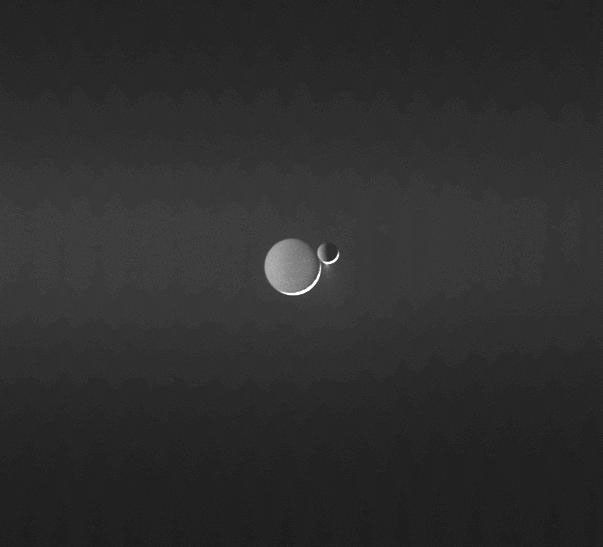Planetglow
| PIA Number | PIA08224 |
|---|---|
| Language |
|
Two frigid moons, Rhea and Enceladus, shine in reflected light from Saturn. In such low light and at great distance, Rhea's cratered surface looks deceptively smooth. Light from the distant Sun creates the bright crescent on each moon and scatters off the icy spray above the south pole of Enceladus.
Rhea is 1,528 kilometers (949 miles) across, and Enceladus is 505 kilometers (314 miles) across.
The image background appears generally brighter across its center due to the diffuse E ring, which is created by the jets of material from Enceladus.
The faint vertical banding in the image is due to "noise" in the spacecraft electronics.
The image was taken in visible light with the Cassini spacecraft narrow-angle camera on June 13, 2006 at a distance of approximately 4.1 million kilometers (2.5 million miles) from Enceladus and 4.5 million kilometers (2.8 million miles) from Rhea. The Sun-Enceladus-spacecraft, or phase, angle is 159 degrees. Image scale is 24 kilometers (15 miles) per pixel on Enceladus and 27 kilometers (17 miles) per pixel on Rhea.
The Cassini-Huygens mission is a cooperative project of NASA, the European Space Agency and the Italian Space Agency. The Jet Propulsion Laboratory, a division of the California Institute of Technology in Pasadena, manages the mission for NASA's Science Mission Directorate, Washington, D.C. The Cassini orbiter and its two onboard cameras were designed, developed and assembled at JPL. The imaging operations center is based at the Space Science Institute in Boulder, Colo.
For more information about the Cassini-Huygens mission visit http://saturn.jpl.nasa.gov . The Cassini imaging team homepage is at http://ciclops.org .
Credit: NASA/JPL/Space Science Institute





























